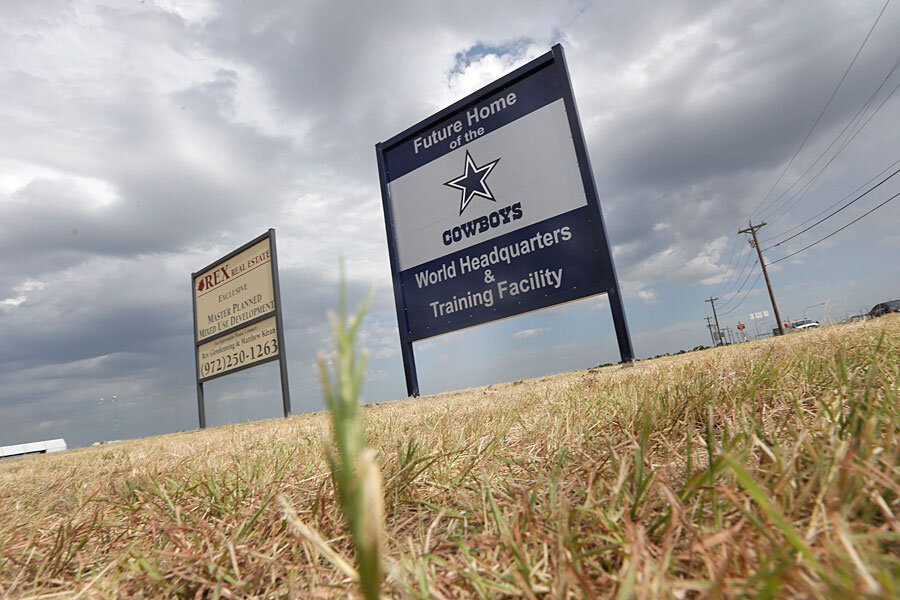Census Bureau charts urban boom: secrets of America’s fastest-growing cities
Loading...
| Atlanta
Life in post-recession America is feeling more and more urban, the latest Census figures show. US cities are logging sometimes stunning growth rates, as retirees, primarily, and younger Americans pour into the boomtowns of the South, Southwest and West.
The demographic forces behind the growth of America’s cities are complex and hard to pin down, especially given that some cities like Philadelphia and Detroit have shrunk. There are even some signs that overall big-city growth, which has anomalously bested suburban growth through the recession and its aftermath, has slowed as smaller and more suburban communities and so-called metro area exurbs make gains.
Indeed, the main growth trend that the Census found was among smaller cities, 14 of which saw their population crack the 50,000 mark in 2013.
Many of the fastest-growing cities are urbanizing smaller towns: While the growth of Austin, Texas, slowed in 2013, three surrounding smaller cities were among the top 15 fastest-growing cities in the country.
The phenomenon of metro-area population boomlets is evident across the United States, though the factors driving the growth of communities from San Marcos, Texas, and Lehi, Utah, to Franklin, Tenn., vary from region to region.
Demographers say it’s the oil-and-gas boom in the West that’s a primary driver of population growth in areas near America’s oil and gas reserves. But given that San Jose and nearby Silicon Valley have surpassed San Francisco in population, it’s clear that proximity to high tech is also a driver of urban growth.
In Lehi, Utah, planners have cited both land availability and its proximity to other tech hotbeds on what’s called the “Silicon Slopes” as reasons for its place among the nation’s Top 15 fastest-growing cities.
“Our location is perfect for this growth because we are located right between Salt Lake County and Utah County. Employers want to draw from both counties,” Lehi City Manager Derek Todd said in a release.
Growth characteristics common to cities like Atlanta, where the post-recession growth rate is now nearly as high as it was before the crash, include one or two well-rated universities, accessible natural beauty for jaunts outside jangling downtowns, and the presence of legacy anchor companies and industries.
And just as natural gas is dominating the boomtowns of the West, new and expanding industries are driving some of the growth elsewhere. One factor in Atlanta’s revived growth is the movie industry, with Liam Neeson’s “Taken 3” and a “Hunger Games” sequel recently wrapping inside the city limits.
As an example of what beckons Americans today, San Marcos, Texas, which led the way nationally with 18 percent growth since 2010, is home to Texas State University and the spring-fed San Marcos River. More importantly, at least for job-seekers, it’s located just 31 miles down I-35 from Austin, which has seen 200 companies move into town in the last two years.
San Marcos Mayor Daniel Guerrero explains that the growth is driven by “a number of folks from New York, from Illinois, California, and Florida that are beginning to make their way toward Texas,” according to Business Week.
Nashville has grown 5.1 percent since 2010, largely on the strength of its country-twang nightlife, local universities like Vanderbilt, and a business scene dominated by health-care management firms. “The cradle of country music could soon grow larger than Boston, the cradle of the American Revolution,” quip Associated Press writers Greg Toppo and Paul Overberg.
Quaint but worn historic neighborhoods are a plus, where young energetic people can still afford to buy and have the prospect of some day flipping at a profit. Cities like Raleigh, N.C., have boomed in part because of nearby Research Triangle Park, but also because of major investments that turned a sleepy downtown that shuttered at dinner time into a place where breweries film hipster commercials and where Red Hat, the global software company, is a cornerstone downtown firm.
These kinds of snapshots of urban growth naturally set off regional sniping, especially since Texas alone had seven of the top 15 fastest-growing cities. Texas Gov. Rick Perry, for one, was pitching New York State-based companies this month, pointing out his state’s easy-going regulatory atmosphere, low tax rates, and well-trained population as reasons why they should relocate.






